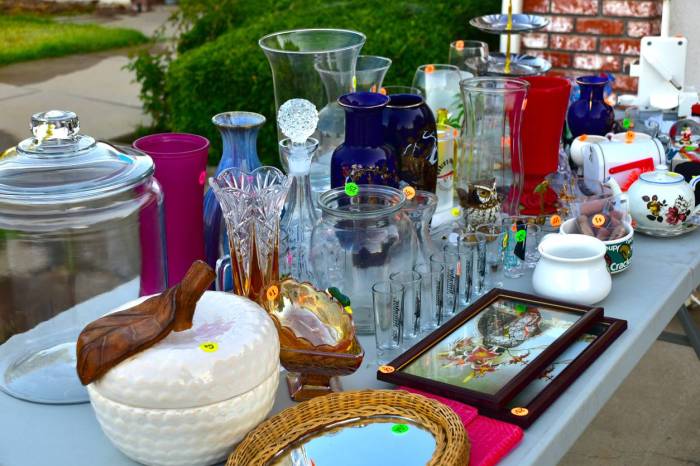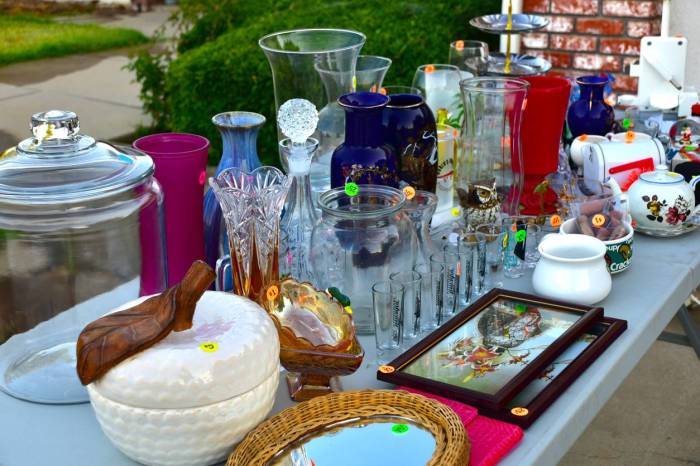
Yard Sale Tips From The Pros: Maximize Your Profits
Yard Sale Tips From The Pros: Maximize Your Profits – Are you planning to host a yard sale but feel overwhelmed by the process? Don’t worry, we’ve got you covered! From choosing the right date to pricing your items strategically, this comprehensive guide will walk you through everything you need to know to turn your yard sale into a success.
Whether you’re a seasoned seller or a first-timer, these tips from the pros will help you attract more customers, maximize your profits, and ensure a smooth and enjoyable experience for everyone involved.
Planning Your Yard Sale
Planning a successful yard sale requires careful consideration and preparation. From selecting the right time and location to promoting your sale effectively, there are several key steps to ensure a profitable and enjoyable experience.
Choosing the Best Time of Year
The best time to host a yard sale is during the spring or fall. These seasons offer pleasant weather, making it more comfortable for both you and potential buyers to browse and shop outdoors.
Planning Your Yard Sale Checklist
A well-organized checklist can help you stay on track and ensure that you’ve covered all the essential aspects of planning your yard sale.
- Determine your sale date and time.Consider factors like weather and local events to maximize foot traffic.
- Gather and sort your items.Categorize your items by type and price to streamline the setup process.
- Price your items appropriately.Research similar items sold at other yard sales or online to set competitive prices.
- Gather necessary supplies.This includes tables, chairs, signage, price tags, bags or boxes for purchases, and cash for change.
- Secure any required permits.Check with your local municipality to determine if you need a permit for your yard sale.
- Promote your yard sale.Utilize various advertising methods like flyers, social media, and online platforms to reach a wider audience.
- Prepare for the day of the sale.Set up your items in an organized and visually appealing manner. Make sure you have ample change and be prepared to answer questions about your items.
Choosing the Right Location
The location of your yard sale is crucial for attracting customers. Consider factors such as visibility, accessibility, and parking availability.
- High-traffic areas.Choose a location with significant foot traffic, such as a busy street corner or a neighborhood park.
- Good visibility.Ensure your yard sale is easily visible from the street, with clear signage to guide customers.
- Parking availability.Provide ample parking space for customers, especially if you anticipate a large turnout.
Setting a Budget and Advertising
Establishing a budget and advertising your yard sale effectively are essential for maximizing your profits.
- Set a realistic budget.Allocate funds for supplies, advertising, and any potential expenses related to the sale.
- Utilize various advertising methods.Flyers, social media posts, online classifieds, and community bulletin boards can effectively reach a wider audience.
- Promote your sale in advance.Give potential buyers ample notice to plan their shopping trip.
- Offer incentives.Consider offering discounts for multiple purchases or early bird specials to encourage customers to visit your yard sale.
Pricing Your Items
Pricing your items for a yard sale is an essential step in maximizing your profits and ensuring a successful event. It involves a delicate balance of considering the item’s condition, market value, and your desired selling price.
Okay, so you’ve got the yard sale basics down – pricing, display, and the art of the haggle. But what about the real secrets from the pros? They know that a little bit of Mother’s Day magic can go a long way, especially when you check out all momsense today 15 mothers day ideas for inspiration.
You can incorporate some of these ideas into your yard sale setup to create a more appealing and festive atmosphere, which can lead to bigger sales and happier customers!
Determining Prices
To determine the best prices for your items, you need to consider their condition and market value. For items in excellent condition, you can price them closer to their retail value. However, for items with wear and tear, you’ll need to adjust the price accordingly.
Here’s a table that Artikels suggested pricing ranges for various item categories:
| Category | Condition | Suggested Price Range |
|---|---|---|
| Clothing | Excellent | $5-$15 |
| Clothing | Good | $2-$8 |
| Clothing | Fair | $1-$3 |
| Books | New/Like New | $5-$10 |
| Books | Used | $1-$5 |
| Electronics | Working | $10-$50 |
| Electronics | Not Working | $1-$5 (for parts) |
| Furniture | Excellent | $20-$100 |
| Furniture | Good | $10-$50 |
| Furniture | Fair | $5-$20 |
Negotiating with Buyers
Be prepared to negotiate with potential buyers. It’s a common practice at yard sales, and it’s often a fun part of the experience. Here are some tips for negotiating:
- Be polite and friendly:A positive attitude can go a long way in making the negotiation process smoother.
- Be open to offers:Be willing to negotiate, but don’t be afraid to stand your ground if you feel the offer is too low.
- Consider bundle discounts:Offer discounts for buyers who purchase multiple items.
- Don’t be afraid to say no:If you’re not comfortable with an offer, it’s okay to decline it.
Setting Up Your Yard Sale
Once you have your items priced and ready to go, it’s time to set up your yard sale for maximum impact. A well-organized and visually appealing setup can attract more customers and lead to more sales.
Yard sales are a treasure trove of hidden gems, but you need to know what you’re looking for to strike gold. From vintage clothing to antique furniture, the possibilities are endless! If you’re a music lover, keep an eye out for vinyl records, and make sure to check out this helpful guide on what to look for when buying vinyl before you shell out your hard-earned cash.
Once you’ve got your music knowledge down, you’ll be a pro at finding the best deals at the next yard sale!
Organizing Your Yard Sale
A well-organized yard sale makes it easier for customers to find what they’re looking for and encourages them to browse longer. Here are some tips for organizing your yard sale:
- Choose a location with good visibility.A corner lot or a spot near a busy street will attract more attention. If you live in a neighborhood with limited traffic, consider setting up your sale in a community park or parking lot.
- Set up clear pathways for customers to walk through.Avoid overcrowding your space with items. Leave enough room for people to move around comfortably.
- Group similar items together.This makes it easier for customers to find what they are looking for. For example, group all the clothes together, all the books together, and all the kitchenware together.
- Use tables and shelves to display your items.This elevates items off the ground and makes them more visible. If you don’t have enough tables, consider using sawhorses and plywood to create makeshift display areas.
- Consider using signs to direct customers to different areas of your yard sale.For example, you could use signs that say “Books,” “Toys,” or “Clothing.”
Displaying Items Effectively, Yard sale tips from the pros
The way you display your items can make a big difference in how they are perceived by customers. Here are some tips for displaying your items effectively:
- Use bright, eye-catching colors.Use tablecloths, blankets, or even colorful sheets to add visual interest to your display.
- Create focal points.Highlight your most valuable or eye-catching items by placing them in prominent positions. For example, you could place a vintage lamp on a table in the center of your yard sale.
- Use props to create vignettes.For example, you could create a vignette with a vintage tea set, a teapot, and a few teacups on a table. This will help customers visualize how they can use the items in their own homes.
- Keep items clean and dust-free.Customers are more likely to buy items that look well-maintained. Wipe down furniture and polish any metal or glass items.
- Display items in a way that is easy to see and touch.Don’t overcrowd tables with too many items. Customers should be able to easily browse your merchandise.
Suggested Display Strategies for Different Item Categories
| Item Category | Suggested Display Strategies |
|---|---|
| Clothing | Hang clothes on racks or use clothing rods to create a mini-boutique. Group clothes by size and type (shirts, pants, dresses, etc.). Use mannequins to display clothing if available. |
| Books | Stack books neatly on shelves or tables. Organize by genre or author. Consider using bookends to keep stacks from toppling over. |
| Toys | Display toys in a way that is engaging for children. Use baskets or bins to organize toys by type (action figures, dolls, stuffed animals, etc.). |
| Furniture | Place furniture in a way that allows customers to see all sides. Clean and polish furniture before the sale. Use throws or cushions to add visual interest. |
| Kitchenware | Group kitchenware by type (plates, bowls, cups, etc.). Use shelves or trays to display items neatly. |
| Electronics | Display electronics in a way that is easy to see and touch. Test electronics before the sale to ensure they are in working order. |
Marketing and Advertising
Getting the word out about your yard sale is crucial for attracting shoppers and maximizing your sales. A well-executed marketing plan can make all the difference in turning your yard sale into a successful event.
Effective Advertising Methods
Effective advertising involves using a mix of strategies to reach a wide audience. Here are some of the most popular methods:
- Flyers and Posters:Print eye-catching flyers and posters and distribute them in your neighborhood, at local businesses, community centers, and libraries. Be sure to include the date, time, and address of your sale. You can also use a template or design software to create professional-looking flyers.
- Social Media:Utilize social media platforms like Facebook, Instagram, and Nextdoor to spread the word about your yard sale. Create a dedicated event page, share photos of your items, and invite friends and family to share the information with their networks.
You know how the pros say to price your yard sale items strategically? Well, I’m starting to think that’s just like knowing how to keep your kids entertained at a restaurant – a little bit of forethought goes a long way.
Check out 5 ideas to keep kids entertained at a restaurant for some great tips. Just like you wouldn’t want to overprice your vintage records, you don’t want to underestimate the power of a well-timed coloring book or a small, quiet toy to keep little ones occupied during a meal.
Include hashtags related to yard sales, your location, and the type of items you’re selling to increase visibility.
- Online Marketplaces:List your yard sale on online platforms like Craigslist, Facebook Marketplace, and OfferUp. These platforms allow you to reach a broader audience and connect with potential buyers who are actively searching for deals. Provide detailed descriptions of your items and include clear photos.
- Local Newspapers and Community Boards:Many local newspapers offer free or low-cost classified advertising options for yard sales. You can also post flyers on community boards at local grocery stores, libraries, and community centers.
- Email and Text Messages:Send out email blasts and text messages to friends, family, and neighbors, inviting them to your yard sale. Include a link to your online listing or a brief description of the items you’re selling.
Eye-Catching Signage
Your yard sale signage should be designed to attract attention and provide clear information to potential buyers. Here are some tips:
- Large and Visible:Use large, bold letters that are easy to read from a distance. Consider using bright colors or contrasting colors to make your signs stand out.
- Clear and Concise:Include the date, time, and address of your yard sale in a clear and concise manner. You can also include a brief description of the items you’re selling, such as “furniture,” “toys,” or “clothing.”
- Creative and Engaging:Use creative wording or graphics to make your signs more appealing. For example, you could use phrases like “Treasures Await!” or “Bargain Hunter’s Paradise.”
- Placement:Place your signs in strategic locations that are visible to passing traffic. Consider placing signs at the entrance of your neighborhood, along major roads, and at nearby businesses.
Social Media and Online Platforms
Social media and online platforms offer powerful tools for promoting your yard sale. Here are some strategies to maximize your reach:
- Create a Dedicated Event Page:On Facebook, create a dedicated event page for your yard sale. Include details about the date, time, address, and a description of the items you’re selling. Encourage attendees to RSVP and share the event with their friends.
- Use Eye-Catching Images:Post high-quality photos of your items on social media and online marketplaces. Showcase the best features of your items and highlight any unique or valuable pieces.
- Engage with Potential Buyers:Respond to comments and questions promptly. Be friendly and helpful, and answer any inquiries about your items.
- Run Contests and Giveaways:Consider running a contest or giveaway to generate excitement and attract more attendees. You could offer a discount on a particular item or give away a free item to a lucky winner.
- Use Relevant Hashtags:Include hashtags related to yard sales, your location, and the types of items you’re selling to increase the visibility of your posts.
Handling Transactions and Customers
The final stage of your yard sale is managing the transactions and interacting with your customers. This is where all your hard work pays off, so it’s crucial to be prepared and create a smooth and positive experience for everyone involved.
Customer Interaction and Answering Questions
Having a friendly and helpful demeanor is key to creating a pleasant shopping experience. Be prepared to answer questions about your items, including their condition, age, and functionality. It’s also helpful to have a general knowledge of the items you’re selling, such as their brand, model, or any unique features.
A well-informed seller can address customer concerns and build trust, potentially leading to a sale.
Payment Methods and Cash Handling
Accepting a variety of payment methods can make your yard sale more convenient for customers. Cash is still the most common form of payment at yard sales, but consider offering other options like:
- Venmo:This popular mobile payment app allows customers to transfer money directly to your account.
- PayPal:PayPal offers a secure way to accept payments from customers with a PayPal account.
- Credit/Debit Cards:If you have a Square reader or similar device, you can accept card payments.
This can be helpful for larger purchases.
When handling cash, it’s essential to prioritize security.
- Keep a cash box:Use a secure cash box or small safe to store cash and make change.
- Count the money:Count the money in front of the customer to ensure accuracy and avoid disputes.
- Avoid large bills:It’s best to avoid accepting large bills, especially if you’re alone or in a less secure area.
Haggling and Negotiating Prices
Haggling is a common practice at yard sales, and it’s important to be prepared to negotiate prices with customers.
- Be flexible:You’ve already priced your items to sell, so be willing to negotiate within a reasonable range.
- Know your bottom line:Determine the minimum price you’re willing to accept for each item.
- Be polite:Even if you don’t accept a customer’s offer, remain polite and respectful.
A good strategy is to offer a small discount for multiple purchases or bundle items together. This can encourage customers to buy more and increase your overall sales.
After the Yard Sale: Yard Sale Tips From The Pros

The yard sale is over, and you’ve hopefully made some good money. But there’s still work to be done! It’s time to clean up, figure out what to do with the unsold items, and get your finances in order.
Cleaning Up and Disposing of Unsold Items
After the hustle and bustle of the yard sale, you’ll need to tidy up your space. It’s a good idea to clean and organize the area where you held the sale. Here are some tips:
- Pack up the remaining items:Gather all the unsold items and pack them away neatly. You can use boxes, bags, or even just pile them in a designated area. This will help you assess what you have left and make decisions about their future.
- Sweep and clean:Give the area a thorough sweep or vacuum to remove any debris left behind. It’s also a good idea to wipe down any tables or surfaces you used.
- Dispose of trash:Collect all the trash and dispose of it properly. Be sure to recycle any recyclable materials.
Maximizing Profits and Managing Finances
Once you’ve tidied up, it’s time to take a look at your finances. You’ve worked hard to earn some money, so make sure you manage it wisely.
- Calculate your profits:Add up all the money you made from the sale and subtract your expenses (like advertising, tables, and refreshments). This will give you a clear picture of your overall profit.
- Set aside a portion for taxes:It’s important to remember that you may have to pay taxes on your yard sale earnings. Consult with a tax professional to determine the appropriate amount to set aside.
- Decide what to do with your profits:Once you’ve accounted for taxes, you can decide how to use the rest of your earnings. You might save it, spend it on something you’ve been wanting, or donate it to charity.
Donating or Recycling Unsold Items Responsibly
Now, you’ll need to decide what to do with the unsold items. There are several options, but the most important thing is to do it responsibly.
- Donate to charity:Many local charities accept donations of clothing, furniture, and other household items. This is a great way to give back to your community and help those in need.
- Sell online:You can try selling your unsold items online through platforms like eBay, Craigslist, or Facebook Marketplace. This might take some time and effort, but it could be a way to recoup some of your investment.
- Recycle or dispose properly:Some items, like electronics or hazardous materials, require special disposal methods. Be sure to research the proper disposal procedures for these items in your area.






